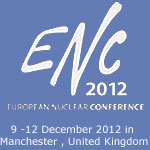
| |
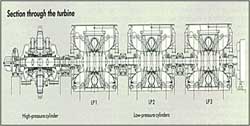 |
 |
Plant visits allowing students to see actual power plant equipment
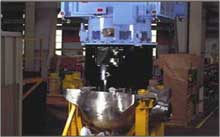 |
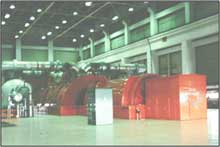 |
Full Scope Simulators duplicate control rooms with detailed mathematical modeling of all plant systems.
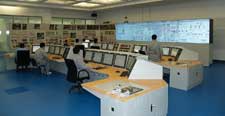 |
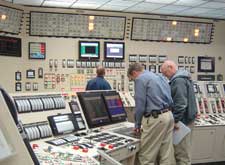 |
Training professionals clearly acknowledge that simulator training is the most effective learning phase among the three methodologies. Simulator training allows “on-the-job training.” The educational community has ranked learning techniques as shown in the learning pyramid, below. “On-the-job training” greatly improves student retention.
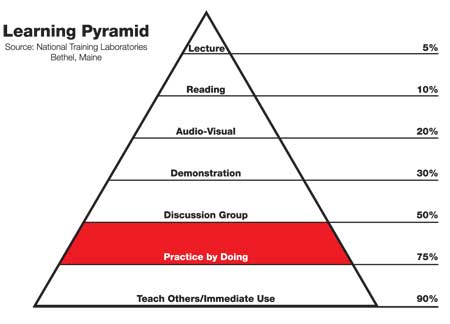
The simulator is the final step in the training process for two main reasons:
-
The reference power plant simulator is designed while the new build power plant is still in the design process
-
Students must understand the many physical systems, processes and their interactions before training on complex plant procedures can be productive and effective.
L-3 MAPPS has received suggestions from colleges and utilities targeting the training of new students in basic nuclear power plant concepts. In their opinion, full-scope simulators provide too much information and detail when a new student is first mastering fundamental concepts. This is the equivalent of studying about flying in the classroom and then attempting to fly a 777 or an A380 for the first time. In the aviation industry, a gradual process of learning to fly begins with smaller basic aircraft and flight simulators the complexity of which gradually increases over years.
Furthermore, new students are technologically savvy and expect to use technology at all stages of their training.
To resolve these dilemmas, L-3 MAPPS has devised a solution that addresses all of these issues and provides for the use of “on-the-job training” earlier in the conventional training cycle. L-3 MAPPS has coupled computer visualisation technology (Bridgeworks) with high fidelity simulation to bring real-time, simulation-driven, animated physical systems allowing immersive, participatory learning in the classroom. With this innovative approach to training, L-3 MAPPS is making it possible to increase student retention rates by making the learning experience that is typical at the top of the learning pyramid much more interactive and efficient. The overarching goal is to provide a rich training environment in which students can interact, discover and retain knowledge more efficiently.
L-3 MAPPS has developed the Learning Simulator. The Learning Simulator may be used at the beginning of and during a training cycle to increase the effectiveness of the training programme, improve retention and complete the training in less time than that taken by traditional methods.
Learning Simulator
The Learning Simulator has the authenticity of a full-scope simulator. It can be operated from a virtual control room using touch screen plant controls or from dynamic plant system representations. The Learning Simulator experience can be instructor-led and/or delivered at each student’s individual place. In addition, simulator and student response data can be automatically collected, plotted, archived and analysed.
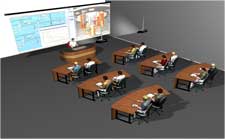 |
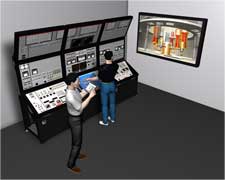 |
Where full-scope simulators are focused on training students in how to operate nuclear plants, the Learning Simulator is designed to instruct students in components, systems and fundamental operational behavior. The visualisations are easily reconfigured to address specific learning objectives in a step-by-step approach that builds students’ knowledge in a systematic way.
The Learning Simulator provides a learning environment that uses mathematical computer simulation as a driver for illustrating nuclear power plant operations and reinforcing the concepts presented in a classroom while at the same time introducing the operating controls of the nuclear power plant. It is a blend of 2-D and 3-D animations coupled with typical nuclear power plant controls. The objective is learning about “how something functions” versus “knowing what switch to turn and when.”
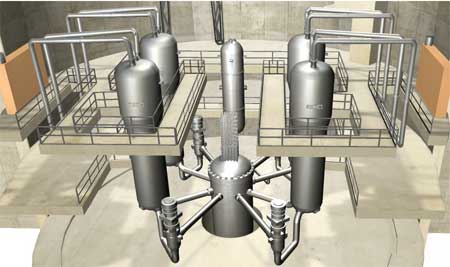
While advanced plant systems knowledge is transferred most effectively with the simulation-driven Learning Simulator, it is equally valuable for component-level or fundamental training. The student can not only see the physical configuration and their operating purpose but can also look inside specific components and learn about their inner workings.
The external casings can be dissolved, rotated and zoomed to display the inner workings of components. Not only are the components identified, but the physical operation is animated, avoiding the difficult task of trying to mentally picture equipment operation from a traditional static 2-D presentation.
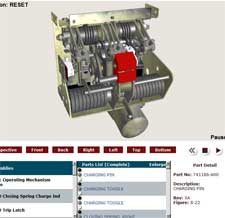 |
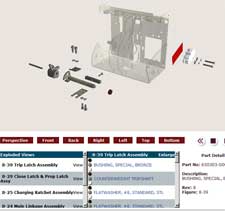 |
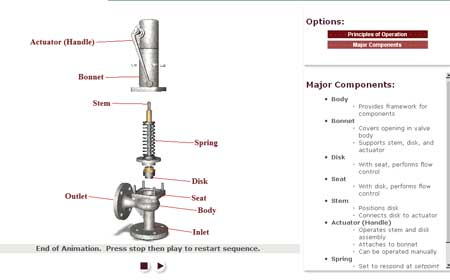
The properties calculated by the simulation models are used to drive the dynamic elements of the 2-D and 3-D models, where the different properties are displayed in relation to a working animated component. Physical properties such as temperature, enthalpy, pressure, etc. are displayed as colour gradients within 3-D plant components themselves, allowing students to easily visualise and understand thermal-hydraulic processes.
Students can also see physical operation as opposed to hearing or reading a description which they would then in turn have to translate into a working model in their mind.
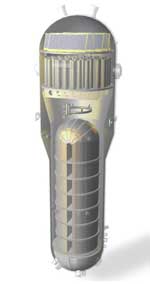 |
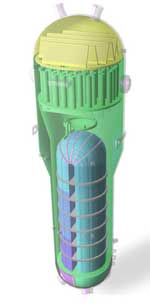 |
Benefits
Training and learning are fundamentally the communication of concepts and the transfer of knowledge. We effortlessly recall images and experiences that we have witnessed. All of these truths support this type of learning medium.
The experiences gained through the Learning Simulator are invaluable and are often logistically unavailable to the student. The Learning Simulator is all about improving the “efficiency of learning” for new nuclear power plant workers.
Other important attributes:
-
Interesting, engaging and effective learning with more content than traditional training approaches
-
Imparts knowledge in minutes instead of hours
-
Improves subject matter retention
-
Encourages independence and self-reliant learning




